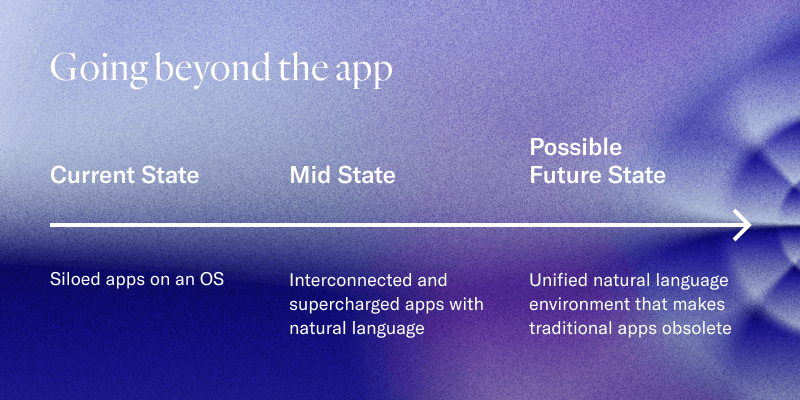
Next-Gen UX: From Apps to Natural Language
Apps reign supreme in our digital world.
We use apps for everything: searching, browsing, learning, writing, reading, communicating, connecting, creating and, of course, completing tasks. Yet, beneath this convenience lies a fragmented reality.
Our digital lives resemble isolated islands of single-purpose apps, each in its own silo, demanding constant attention. This leads to a disjointed user experience where brand ecosystems overshadow our evolving, diverse needs as individuals.
The reality is that apps and websites aren’t always the best ways to get the job done. In particular, they are terrible for completing more nuanced tasks, requiring continuous task-switching and leading to increased mental load. Take, for example, comparing costs to book a flight. You’d first need to scan various sites or apps, compare prices, routes and then come back to your preferred option to book. Current price comparison sites exist today but are too clunky to make booking a smooth process. Plus, the lack of pricing transparency and complexity of such a search make these sites hard to trust and harder to navigate.
However, a revolution is underway, spurred by the fertile grounds of Generative AI (Gen AI). We are witnessing a pivotal shift from app-centric to natural language-centric experiences, where user journeys transcend individual platform boundaries, transforming frustrating, disconnected interactions into integrated, holistic experiences.
The emergence of real-time interactions
Today’s consumers, especially Gen Z and Gen Alpha, yearn for real-time, anticipatory experiences. They envision AI as an invisible assistant, seamlessly coordinating tasks and services across platforms, delivering insights and solutions instantaneously.
This transformation is exemplified by the Rabbit r1, an innovative personal AI assistant. Its Large Action Model (LAM), a type of “universal controller for apps,” not only learns your preferences, but performs actions aligned with them: anticipating your needs and seamlessly orchestrating tasks across various apps. Imagine planning a weekend getaway. Once trained on your preferences, the r1 could manage everything—from flights and hotels to restaurant reservations and activity bookings—crafting a seamless tapestry of experiences rather than a disjointed series of app interactions. Or train it to streamline paying bills, avoiding the need for dealing with a phone tree or unresponsive online forms.
More AI-driven examples demonstrate how the app as we know it may be losing ground. At 2024’s Mobile World Congress, Deutsche Telekom debuted an app-free phone. The company’s CEO Tim Hoettges went as far as to say, “I can tell you that in 5 – 10 years from now, nobody from us will use apps anymore.”

Designing for the future
In this emerging landscape, we face unique challenges and opportunities. A natural language-centric revolution means that our primary way of interacting with digital devices will mirror how we interact with each other. We won’t need to navigate through multiple apps to complete an action. We’ll just say what we need into our devices, by chat interactions and voice recognition. This paradigm shift will revolutionize our approach to product and service design, making natural language-centric interaction the standard. The competitive edge will increasingly be defined by the service delivery model, rather than just the user interface.
Building trust is critical when actions occur behind the scenes. We need to design for ethical and transparent AI, giving users control over their data privacy. To build trust in this first stage of the AI revolution, it is critical to give users the ability to verify and modify the data and outputs from LLMs and LAMs.
We must break down the barriers between apps, enabling seamless data and service exchange. Imagine an AI assistant that integrates with your calendar, fitness tracker and music streaming service, personalizing your schedule, workouts and playlists based on real-time needs and preferences.
Future experiences must dynamically adapt to user needs through contextual awareness. The Large Action Model allows every person to train their experiences. For instance, your home could transform into a spa-like environment for relaxation, with lights dimming and chill music playing automatically as you walked through the door after a busy day.
Prioritizing emotional resonance in design is essential, rather than focusing solely on task efficiency. A mental health service, for instance, could function as an empathetic companion, engaging you with thoughtful questions, active listening and reflective conversations, all attuned to your current mood and emotional state.
In a future guided by AI’s recommendations, content generation and optimized experiences, maintaining the uniqueness of personal and brand expression is crucial. While AI streamlines and unifies, we must create spaces away from uniformity. We want people and brands to have the freedom to explore, develop unique tastes and craft dynamic narratives. Such intentional design strategies are key to preserving diversity and promoting the richness of personal and brand expression in an AI-assisted landscape.
Embrace the app-free paradigm shift
We stand at the forefront of not only new products and technologies, but also a paradigm shift. Both new ventures and established businesses are taking notice. Tomorrow’s users will seek experiences that flow as naturally as their thoughts and emotions.
The natural language-centric revolution is here. Are you prepared to design for it? Let’s embark on this journey together, reshaping the digital landscape to be more intuitive, empathetic, efficient and aligned with our human needs.
This article is the first in a series exploring potential futures driven by AI’s impact on our interactions with organizations and each other. Our next article explores new ways to think about designing for AI-powered experiences.

Antonello sees design as an act of love and care, a continuous dialogue aimed at improving people’s lives. As a Head of Design, he leads a team of thinkers and makers, leveraging over 20 years of global experience across diverse industries and cultures. Together, Antonello and his team dive into every project with a simple goal: to craft meaningful experiences that touch lives and forge a better future. He’s passionate about bringing out the best in his team, inspiring them to fuse craft with science in ways that truly resonate with people.

As Head of frog North America, Jess is responsible for leading the frog business in North America. With a background in Service Design, Jess has spent the past 15 years leading teams in the design and launch of new products, services and businesses. Prior to frog, Jess was the Head of Service Design and Head of Studio at idean. Originally from Sydney, Australia, she lived in London for a number of years before moving to the US in 2019. In London, she received her Masters in Service Design.

Jason has struggled for over 25 years to understand the evolving tensions between creativity, business and technology and is obsessed with the idea of radical change though solution design focused on the human experience. Before his recent return to frog, he was the first Chief Design Officer of Droga5, part of Accenture Song, where he built a team that delivered brand identity and digital experience outcomes for several of the agency’s major accounts. Prior to that, he built a strategic initiatives team at Verizon focused on improving customer experiences through Verizon’s digital and retail channels.
We respect your privacy
We use Cookies to improve your experience on our website. They help us to improve site performance, present you relevant advertising and enable you to share content in social media. You may accept all Cookies, or choose to manage them individually. You can change your settings at any time by clicking Cookie Settings available in the footer of every page. For more information related to the Cookies, please visit our Cookie Policy.